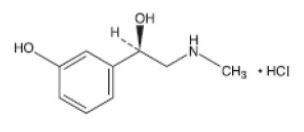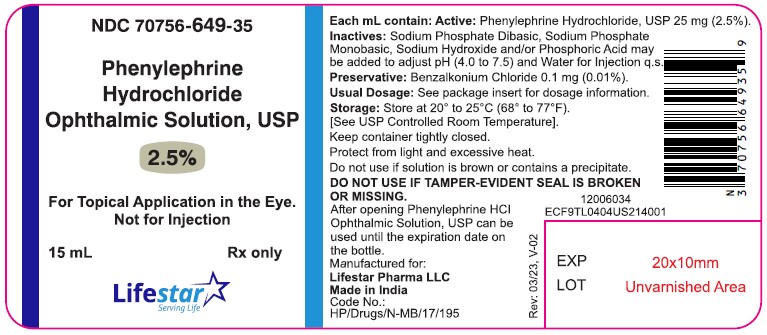FULL PRESCRIBING INFORMATION
1 INDICATIONS AND USAGE
Phenylephrine Hydrochloride Ophthalmic Solution 2.5%, is indicated to dilate the pupil.
2 DOSAGE AND ADMINISTRATION
2.1 General Dosing Recommendations
In patients 1 year of age or greater, apply one drop of phenylephrine hydrochloride ophthalmic solution 2.5% every 3 to 5 minutes to the conjunctival fornix as required up to a maximum of 3 drops per eye per day.
In order to obtain a greater degree of mydriasis, phenylephrine hydrochloride ophthalmic solution 10% may be needed.
3 DOSAGE FORMS AND STRENGTHS
Phenylephrine hydrochloride ophthalmic solution, USP 2.5% is a clear, colorless to yellow colored sterile topical ophthalmic solution containing phenylephrine hydrochloride 2.5%.: each mL contains 25 mg of phenylephrine hydrochloride, USP.
4 CONTRAINDICATIONS
4.1 Cardiac and Endocrine Disease
Phenylephrine hydrochloride ophthalmic solution 10% is contraindicated in patients with hypertension or thyrotoxicosis. Phenylephrine hydrochloride ophthalmic solution 2.5% should be used in these patients.
4.2 Pediatric Patients Less Than 1 Year of Age
Phenylephrine hydrochloride ophthalmic solution 10% is contraindicated in pediatric patients less than 1 year of age due to the increased risk of systemic toxicity. Phenylephrine hydrochloride ophthalmic solution 2.5% should be used in these patients [See Dosage and Administration (2.2)].
5 WARNINGS AND PRECAUTIONS
5.1 Topical Ophthalmic Use Only
Phenylephrine hydrochloride ophthalmic solution 2.5% is not indicated for injection.
5.2 Cardiovascular Reactions
There have been reports of serious cardiovascular reactions, including ventricular arrhythmias and myocardial infarctions, in patients using phenylephrine 10%. These episodes, some fatal, have usually occurred in patients with pre-existing cardiovascular diseases. Phenylephrine Hydrochloride Ophthalmic Solution 2.5% should be used in these patients.
5.3 Elevation of Blood Pressure
A significant elevation in blood pressure is not common but has been reported following conjunctival instillation of recommended doses of phenylephrine 10%. The risk is less with phenylephrine 2.5%. Caution should be exercised with the use of phenylephrine 10% in pediatric patients less than 5 years of age and patients with hyperthyroidism, or cardiovascular disease. The post-treatment blood pressure of patients with cardiac and endocrine diseases and any patients who develop symptoms should be carefully monitored.
6 ADVERSE REACTIONS
The following serious adverse reactions are described below and elsewhere in the labeling:
- Cardiovascular Effects [See Warnings and Precautions (5.2 )]
- Elevation in Blood Pressure [See Warnings and Precautions (5.3 )]
The following adverse reactions have been identified following use of phenylephrine hydrochloride ophthalmic solution. Because these reactions are reported voluntarily from a population of uncertain size, it is not always possible to reliably estimate their frequency or establish a causal relationship to drug exposure.
6.1 Ocular Adverse Reactions
Eye pain and stinging on instillation, temporary blurred vision and photophobia, and conjunctival sensitization may occur.
6.2 Systemic Adverse Reactions
A marked increase in blood pressure has been reported particularly, but not limited to low weight premature neonates, infants and hypertensive patients.
Cardiovascular effects which have been seen primarily in hypertensive patients following topical ocular use of phenylephrine hydrochloride ophthalmic solution 10% include marked increase in blood pressure, syncope, myocardial infarction, tachycardia, arrhythmia and subarachnoid hemorrhage [See Warnings and Precautions (5.2 and 5.3)].
8 USE IN SPECIFIC POPULATIONS
8.1 Pregnancy
Animal reproduction studies have not been conducted with topical phenylephrine. It is also not known whether phenylephrine can cause fetal harm when administered to a pregnant woman or can affect reproduction capacity. Phenylephrine hydrochloride should be given to a pregnant woman only if clearly needed.
8.3 Nursing Mothers
It is not known whether this drug is excreted in human breast milk. Because many drugs are excreted in human milk, caution should be exercised when phenylephrine hydrochloride ophthalmic solution 2.5% is administered to a nursing woman.
8.4 Pediatric Use
Phenylephrine hydrochloride ophthalmic solution 10% is contraindicated in pediatric patients less than 1 year of age [See Contraindications (4.2)].
10 OVERDOSAGE
Overdosage of phenylephrine may cause a rapid rise in blood pressure. It may also cause headache, anxiety, nausea, and vomiting, and ventricular arrhythmias. Prompt injection of a rapidly acting alpha-adrenergic blocking agent such as phentolamine has been recommended.
11 DESCRIPTION
Phenylephrine Hydrochloride Ophthalmic Solution, USP is a sterile, clear, colorless to yellow color solution, topical α -adrenergic agonist for ophthalmic use. The active ingredient is represented by the chemical structure:

Chemical Name: (R)-3-hydroxy-α[(methylamino)methyl]benzenemethanol hydrochloride.
Molecular Formula: C9H13NO2.HCl
Molecular Weight: 203.67 g/mol
Each mL of Phenylephrine Hydrochloride Ophthalmic Solution, USP 2.5% contains: ACTIVE: Phenylephrine Hydrochloride, USP 25 mg (2.5%); INACTIVES: Sodium Phosphate Monobasic, Sodium Phosphate Dibasic, Water for Injection. Phosphoric Acid and/or Sodium Hydroxide may be added to adjust pH (4.0 to 7.5). The solution has a tonicity of 340 mOsm/kg; PRESERVATIVE: Benzalkonium Chloride 0.1 mg (0.01%).
12 CLINICAL PHARMACOLOGY
12.1 Mechanism of Action
Phenylephrine hydrochloride is an α-1 adrenergic agonist drug that is used in ophthalmology mainly for its mydriatic effect. After topical application to the conjunctiva, phenylephrine acts directly on α-adrenergic receptors in the eye, producing contraction of the dilator muscle of the pupil and constriction of the arterioles in the conjunctiva.
12.2 Pharmacodynamics
Maximal mydriasis occurs in 20 to 90 minutes with recovery after 3 to 8 hours.
Systemic absorption of sufficient quantities of phenylephrine may lead to systemic α-adrenergic effects, such as rise in blood pressure which may be accompanied by a reflex atropine-sensitive bradycardia.
14 CLINICAL STUDIES
Pupillary dilation following topical administration of phenylephrine hydrochloride ophthalmic solution has been demonstrated in controlled clinical studies in adults and pediatric patients with different levels of iris pigmentation. Pupil movement is generally seen within 15 minutes, maximal mydriasis between 20 to 90 minutes and recovery after 3 to 8 hours. Darker irides tend to dilate slower than lighter irides.
16 HOW SUPPLIED/STORAGE AND HANDLING
Phenylephrine hydrochloride ophthalmic solution, USP 2.5% is supplied as a clear, colorless to yellow colored sterile, aqueous, topical ophthalmic solution in an opaque, white low density polyethylene (LDPE) bottle with a natural LDPE dropper tip and red cap in the following sizes:
NDC 70756-629-25 2 mL in 5 mL bottle
NDC 70756-649-35 15 mL in 15 mL bottle
After opening, Phenylephrine Hydrochloride Ophthalmic Solution, USP can be use until the expiration date on the bottle.
Storage: Store at 20° to 25°C (68° to 77°F). [See USP Controlled Room Temperature]. Keep container tightly closed. Protect from light and excessive heat.
Do not use if solution is brown or contains precipitate.
17 PATIENT COUNSELING INFORMATION
Advise patients not to touch the dropper tip to any surface as this may contaminate the solution. Inform patients that they may experience sensitivity to light and should protect their eyes in bright illumination while their pupils are dilated.
Manufactured for:
Lifestar Pharma LLC
1200 MacArthur Blvd.
Mahwah, NJ 07430 USA
Made in India
Revised: March 2023, V-03
PACKAGE LABEL.PRINCIPAL DISPLAY PANEL
Phenylephrine Hydrochloride Ophthalmic Solution, USP
2.5%
For Topical Application in the Eye.
Not for Injection
2 mL
Rx only

Phenylephrine Hydrochloride Ophthalmic Solution, USP
2.5%
For Topical Application in the Eye.
Not for Injection
2 mL
Rx only

Phenylephrine Hydrochloride Ophthalmic Solution, USP
2.5%
For Topical Application in the Eye.
Not for Injection
15 mL
Rx only

Phenylephrine Hydrochloride Ophthalmic Solution, USP
2.5%
For Topical Application in the Eye.
Not for Injection
15 mL
Rx only
